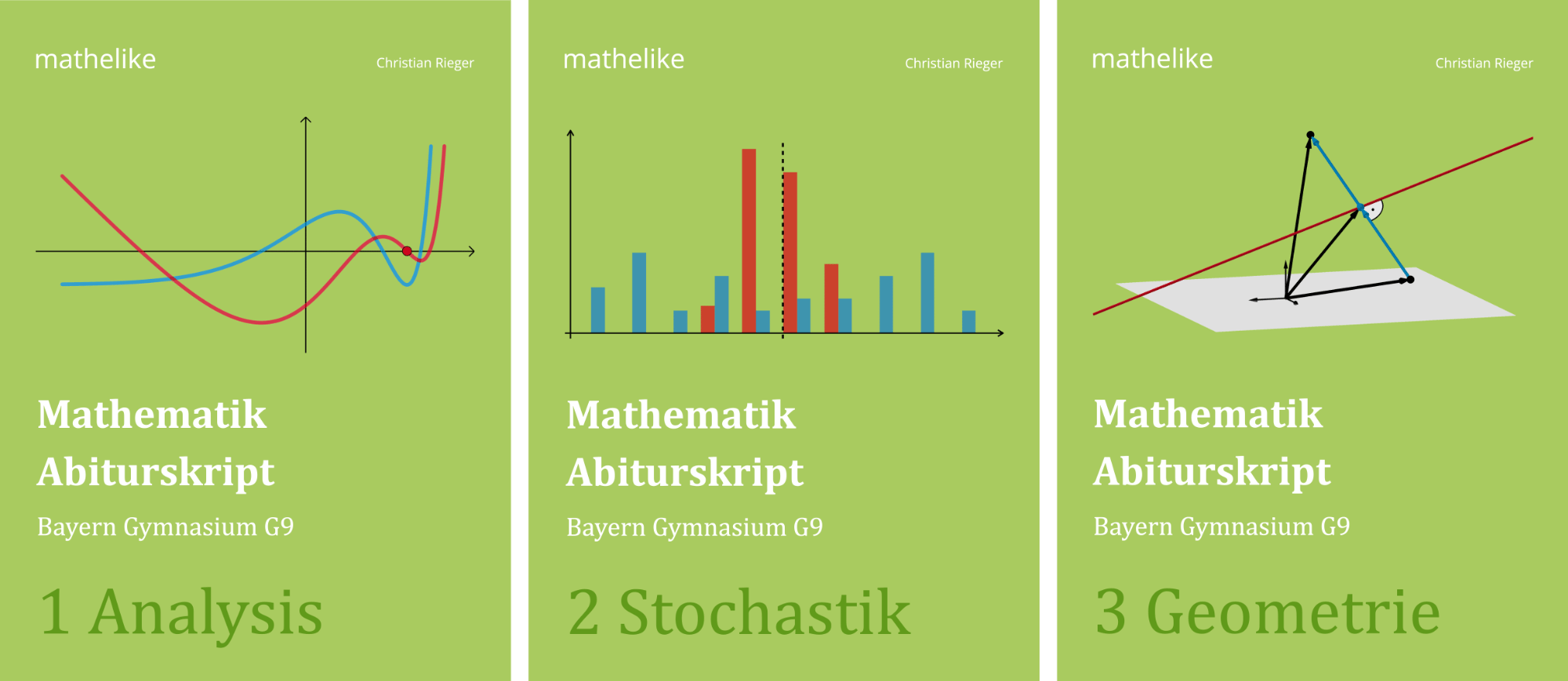Geben Sie das Verhalten für \( x \to -\infty\) sowie für \(x \to +\infty\) an.
(2 BE)
Lösung zu Teilaufgabe 1b
\[f(x) = \frac{x^2-9}{x+2}; \; D_f = \mathbb R \backslash \{-2\}\]
\[\lim \limits_{x\,\to\,-\infty} f(x) = -\infty\]
\[\lim \limits_{x\,\to\,+\infty} f(x) = +\infty\]
Ausführliche Grenzwertbetrachtung (nicht verlangt)
Die Grenzwertbetrachtung von \(f(x)\) für \(x \to -\infty\) bzw. \(x \to +\infty\) führt auf den unbestimmten Ausdruck \(\frac{+\infty}{-\infty}\) bzw. \(\frac{+\infty}{+\infty}\). Für eine aussagekräftige Grenzwertbetrachtung wird die höchste im Nenner vorkommende Potenz im Zähler und im Nenner ausgeklammert und gekürzt.
\[\begin{align*}\lim \limits_{x\,\to\,-\infty} f(x) &= \lim \limits_{x\,\to\,-\infty} \frac{x^2-9}{\textcolor{#e9b509}{x}+2} \\[0.8em] &= \lim \limits_{x\,\to\,-\infty} \frac{\cancel{\textcolor{#e9b509}{x}} \cdot \big( x - \textcolor{#0087c1}{\overset{\to\,0}{\frac{9}{x}}} \big)}{\cancel{\textcolor{#e9b509}{x}} \cdot \big( 1 + \textcolor{#0087c1}{\underset{\to\,0}{\frac{2}{x}}} \big)} \\[0.8em] &= -\infty\end{align*}\]
\[\begin{align*}\lim \limits_{x\,\to\,+\infty} f(x) &= \lim \limits_{x\,\to\,+\infty} \frac{x^2-9}{\textcolor{#e9b509}{x}+2} \\[0.8em] &= \lim \limits_{x\,\to\,+\infty} \frac{\cancel{\textcolor{#e9b509}{x}} \cdot \big( x - \textcolor{#0087c1}{\overset{\to\,0}{\frac{9}{x}}} \big)}{\cancel{\textcolor{#e9b509}{x}} \cdot \big( 1 + \textcolor{#0087c1}{\underset{\to\,0}{\frac{2}{x}}} \big)} \\[0.8em] &= +\infty\end{align*}\]
Ergänzung (nicht verlangt)
Diese ausführliche Grenzwertbetrachtung eignet sich nicht, um die schräge Asymptote des Graphen von \(f\) nachzuweisen (Zählergrad = Nennergrad +1). Hierfür müsste eine Polynomdivision (nicht abiturrelevant) mit anschließender Grenzwertbetrachtung durchgeführt werden.
Asymptoten gebrochenrationaler Funktionen
Eine Funktion \(f(x) = \dfrac{p(x)}{q(x)} = \dfrac{\textcolor{#cc071e}{a_{m}}x^{\textcolor{#cc071e}{m}} + a_{m - 1}x^{m - 1} + \dots + a_{1}x +a_{0}}{\textcolor{#0087c1}{b_{n}}x^{\textcolor{#0087c1}{n}} + b_{n - 1}x^{n - 1} + \dots + b_{1}x + b_{0}}\), die sich als Quotient zweier ganzrationaler Funktionen (Polynome) \(p(x)\) und \(q(x)\) darstellen lässt, heißt gebrochenrationale Funktion. Die Nullstellen des Nennerpolynoms \(q(x)\) können nicht in der Definitionsmenge \(D_{f}\) enthalten sein und werden als Definitionslücken bezeichnet.
Senkrechte Asymptoten
Wenn an einer Definitionslücke \(x_{0}\) einer gebrochenrationalen Funktion \(f\)
\(\begin{align*}\lim \limits_{x\,\to\,x_{0}^{-}}f(x) = +\infty \enspace &\text{oder} \enspace \lim \limits_{x\,\to\,x_{0}^{-}}f(x) = -\infty \\[0.8em] \text{und} \enspace \lim \limits_{x\,\to\,x_{0}^{+}}f(x) = +\infty \enspace &\text{oder} \enspace \lim \limits_{x\,\to\,x_{0}^{+}}f(x) = -\infty \end{align*}\)
gilt, so nennt man \(x_{0}\) eine Polstelle von \(f\) und die Gerade mit der Gleichung \(x = x_{0}\) ist senkrechte Asymptote des Graphen von \(f\).
Waagrechte und schräge Asymptoten
Der Graph einer gebrochenrationalen Funktion \(f\) hat für \(x \to - \infty\) bzw. \(x \to + \infty\) im Fall
| \(\textcolor{#cc071e}{m} < \textcolor{#0087c1}{n}\): | die \(x\)-Achse \((y = 0)\) als waagrechte Asymptote, |
| \(\textcolor{#cc071e}{m} = \textcolor{#0087c1}{n}\): | eine waagrechte Asymptote parallel zur \(\boldsymbol{x}\)-Achse mit der Gleichung \(y = \dfrac{\textcolor{#cc071e}{a_{m}}}{\textcolor{#0087c1}{b_{n}}}\), |
| \(\textcolor{#cc071e}{m} = \textcolor{#0087c1}{n} + 1\): | eine schräge Asymptote, |
| \(\textcolor{#cc071e}{m} > \textcolor{#0087c1}{n} + 1\): | keine waagrechte oder schräge Asymptote. |
\((x^2-9):(x+2) = x-2-\dfrac{5}{x+2}\) (durch Polynomdivision, ohne Nachweis)
\[\begin{align*}\lim \limits_{x\,\to\,-\infty} f(x) &= \lim \limits_{x\,\to\,-\infty} \bigg( \textcolor{#cc071e}{x-2}-\textcolor{#0087c1}{\underbrace{\frac{5}{x+2}}_{\to\,0}} \bigg) \\[0.8em] &= \lim \limits_{x\,\to\,-\infty} (\textcolor{#cc071e}{x-2}) \\[0.8em] &= -\infty\end{align*}\]
\[\begin{align*}\lim \limits_{x\,\to\,+\infty} f(x) &= \lim \limits_{x\,\to\,+\infty} \bigg( \textcolor{#cc071e}{x-2}-\textcolor{#0087c1}{\underbrace{\frac{5}{x+2}}_{\to\,0}} \bigg) \\[0.8em] &= \lim \limits_{x\,\to\,+\infty} (\textcolor{#cc071e}{x-2}) \\[0.8em] &= +\infty\end{align*}\]
Schräge Asymptote mit der Gleichung \(y = \textcolor{#cc071e}{x-2}\)
Für einen abiturrelevanten rechnerischen Nachweis einer schrägen Asymptote (ohne Polynomdivision) ist eine gebrochenrationale Funktion in der „günstigen" Form \(f(x) = \textcolor{#cc071e}{x-2}-\dfrac{5}{x+2}\) gegeben.


